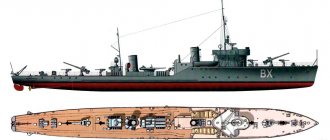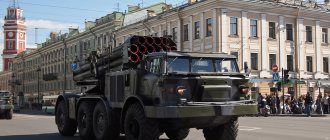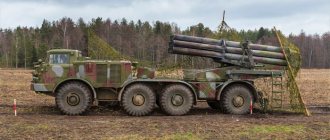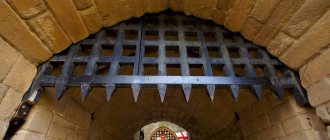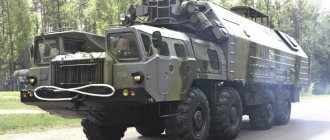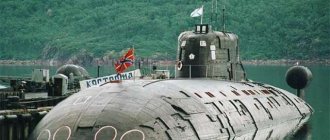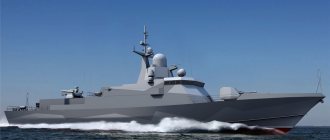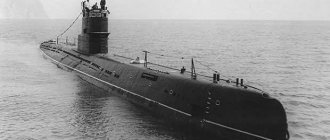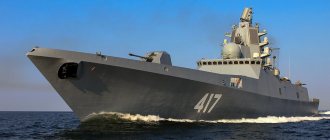Work on the design of the Hurricane
In the USSR, they actively worked on the construction of combat-ready ships based on submerged wings. Back in the 30s, the first experiments on such projects began. Already in 1937, TsAGI designers began to arrange real tests of the created “winged” boats. After the end of World War II, in the late 40s and early 50s, work on such ships was resumed. The best Soviet design and engineering minds were fascinated by the idea of reducing friction on the water by raising the ship's hull above the waterline.
During testing, Soviet engineers created ships based on hydrofoils for non-combat use. In this direction, the USSR won its recognition throughout the world.
“Comets”, “Rockets” and “Meteors” became a kind of calling card for Soviet shipbuilding.
Passenger ships were in demand far beyond the country's borders and were exported even to Western countries. Naturally, such successes would remain unattainable. If not for the development of military hydrofoil missile ships. All the invested efforts of the Soviet design bureau were fully rewarded at the end of the 50s. All work to improve the technical and mechanical equipment of the large torpedo boat 206M “Storm” was completed, after which it was put into wide production. In parallel with this, small missile-carrying boats were also rapidly developing.
Worldwide curiosity about these ships arose after a naval battle that happened in 1967. Then a pair of Egyptian missile-carrying boats of the Komar type, produced in the USSR, sent the destroyer Elite, owned by Israel, as fish food.
This was the first time in history that a ship was sunk using anti-ship shells.
The Soviet Union pursued the idea of combining "cruise" ships with advanced missile launchers that could move quickly through the water, even by today's standards. In order to quickly implement this idea, a small missile-carrying boat was launched. Subsequently called "Hurricane".
The design of the vessel began in 1964 within the walls of TsKB-5. Their task was to create a ship that was required to develop colossal speed due to its deeply submerged wings. Work on the promising project was headed by V.M. Burlakov, under whose leadership a prototype of the civilian vessel “Typhoon” was also created, based on the principle of wings submerged in water.
The resulting passenger ship was launched in 1969 and performed its functions until the 70s as part of the river shipping company. All the results achieved during the trial operation of the Typhoon were carefully analyzed and applied to improve the design features of the Hurricane. It should be noted that the civilian version could reach a top speed of up to 50 knots, which is a very impressive figure.
The only completed example of the Uragan missile ship, which later received the marking MRK-5 and assembled in Leningrad, entered the stage of active military testing in 1976.
In December of the following year, the MRK officially ended up in the Baltic Fleet. The ship was in experimental use for a whole year, after which it was redirected to the Black Sea. The boat managed to reach the shores of Sevastopol in 1979, becoming part of the 166th division of the Black Sea Fleet, serving there until its expulsion from the composition in 1990.
Service[ | ]
Marine parade in St. Petersburg, July 26, 2022.
The lead small missile ship of Project 22800 “Mytishchi” became part of the Baltic Fleet of the Russian Navy on December 17, 2018[9].
In the period from June 25 to June 30, 2022, he took part in the IMF “Army-2019” at the forum site in Kronstadt[10].
In the period from July 10 to July 14, 2022, he took part in the work of IMDS-2019[11].
On July 28, 2022, he took part in the Main Naval Parade[12].
From August 1 to August 9, 2022, he took part in the Ocean Shield 2019 exercises[13].
Technical features of MRK-5 "Hurricane"
Even during its construction, the newest missile ship literally amazed the sophisticated imagination with its capabilities. It used the most advanced technical solutions, and the dimensions of the boat were impressive. At the stage of its full readiness, the Hurricane was the largest ship on the globe that used deep-sunk wings. In comparison with surface vessels, the RTO could not be called a giant. It had a displacement of 342 to 432 tons.
The relatively short length of the vessel (only 56.6 meters) with a width of 10.17 m instantly increased to a value of 21.14 m when the wings were removed from the water. The draft at maximum speed was 2.35 m, and the Hurricane was controlled by a team of 34 people, seven of whom had officer ranks.
The hull of the new vessel was made of a special alloy of aluminum and magnesium, and the hydrofoils were created from a high-strength titanium alloy. The size of these wings can be imagined from the increase in the width of the ship when they are raised, or from several photographs kept in shipbuilding museums. When raised, each of the wings moved to the side by 45 degrees, and automated systems for precise lift control allowed the MRK to maintain balance regarding height above the waterline, trim or roll.
The vessel was driven by a modern high-power gas turbine engine with two turbines. With the help of gearboxes, rotation was transmitted to the propellers, which were installed in the aft columns of the wings to ensure rowing. Each column carried a pair of propellers. The maximum engine power was 36 thousand horsepower. Such power was entirely enough for the unique boat to provide a speed of 56-60 knots.
To propel the Hurricane, with the wing columns raised above the water, a power diesel engine was used, which had a power of only 2200 horsepower. It had only a couple of diesel engines, designed to work strictly to power water-jet propulsion. In a modified state, the maximum speed reached 9-10 knots.
Food supplies in the holds allowed the crew to exist autonomously for 5 days. At a speed of about 45 knots, the duration of the RTO ranged about 700 miles, and when the speed was reduced to 8.5 knots, it was possible to cover a distance of one and a half thousand miles. For a vessel based on deep-sunk wings, the Hurricane could boast very impressive seaworthiness. This indicator, when moving with the wings down, was estimated at a decent 5 points. In such sea conditions, the MRK-5 maintained its speed at 55 knots. With the displacement state of the ship, seaworthiness reached 7 points.
Construction of the lead patrol ship "Hurricane"
Construction of the lead ship was completed at the end of the summer of 1930, and on August 27, it was tested for stability in the waters of the Northern Shipyard. With a bow draft of 1.60 m and a stern of 1.75 m, which corresponded to a displacement of 328 tons, the initial transverse metacentric height was 0.54 m. Exactly a month later, on September 27, the ship with the factory crew made its first, albeit short-lived, exit in the sea. 5 miles were covered and 7.9 tons of oil were consumed. On September 30, an artillery test was carried out, with 11 shots fired from each 102-mm gun. The total capacity of the bow and stern magazines was determined to be 408 rounds.
"Thunderstorm" - one of the "hurricanes" during the Second World War
On October 22, the Hurricane went to sea for factory sea trials. Since they received only 485 rpm of propeller shafts instead of the required 630, the tests were repeated the next day. This time the number of revolutions per minute was 540... It was difficult to call it a success, but in the absence of anything else, the ship was shown to the selection committee.
On October 27, the tests continued - the ship with members of the commission on board went to sea to conduct 4-hour tests at full speed. When surveyed from anchor, the draft was 2.28 m bow and 2.16 m stern, which corresponded to a displacement of 484 tons, and this was 84 tons (that is, 21%!) higher than the design. In total, the Hurricane completed four runs on a measured mile between the Nerva and Big Somers lighthouses. The average speed was 25.78 knots at 577 rpm propellers. The average gross power measured at the turbine couplings with Chatbourne torsiometers was found to be 6820 hp. During the test, the ship traveled 288 miles and consumed 34 tons of fuel.
At the beginning of November, training firing was carried out, and during the final tests on November 22, 1930, at least they managed to repeat the results from the 27th. At this point, the Hurricane tests were completed. The test report stated that the design parameters of the project were: speed of 29 knots with a total gross turbine power of 7500 hp. and a displacement of 400 tons were not achieved. There were also no 37 mm belt-fed machine guns, 12.7 mm machine guns or a radio station. The smoke screen, the device for dropping depth charges and the paravanes were also not tested, due to the fact that they simply did not have time to be manufactured and installed on time.
Same camouflage as in the photo above, but this time it's "Storm"
December 9 Namorsi R.A. Muklevich imposed a resolution on the test report: “I approve. The vessel is accepted conditionally. During the winter, eliminate all defects that affect the speed and achieve its increase. The achieved results are considered unacceptable,” and on December 14, in the waters of the Northern Shipyard, a ceremonial raising of the naval flag took place on the Hurricane, after which it was enlisted in the division of patrol ships of the Naval Forces of the Baltic Sea.
Unfortunately, neither over the winter, nor the next year, nor even on all the subsequent 5 ships of the 1st series of Project No. 2, the noted defects were eliminated. Moreover, starting from the third ship (“Smerch”), they even stopped noting this fact in the acts.
However, with the launch of the Whirlwind (the 6th ship), the commission nevertheless called on the shipbuilders, if not to answer, then at least to take their heads: “It is proposed that the Northern Shipyard and TsKBS-1 answer the question about the reasons for the lack of speed at all patrol ships, supported by digital materials.” Serious debriefing began.
Hurricane's combat potential
Despite its small dimensions, the small missile-carrying boat "Hurricane" carried very serious and deadly weapons. The ship's key combat capabilities were represented by two integrated P-120 Malachite anti-ship launchers.
The missiles they fired could reach targets at a distance ranging from 15 to 150 kilometers.
The Malachite system missiles had a launch weight of 5.4 tons with a warhead weighing 0.8 tons. There was also the possibility of installing installations for launching nuclear projectiles with a yield of up to 2 megatons. The diameter of such a rocket was 0.8 meters, length 8.84 meters with a wingspan of 2.5 meters. The Malachite anti-ship missiles were made according to the subsonic principle, and the maximum flight speed of the missile exceeded 1100 km/h.
In addition to the missile system, there was also an anti-aircraft installation on board the Uragan - a two-boom air defense system of the Osa-M system with a set of two dozen missiles. The ship's installation differed from land-based models of this complex in that it could simultaneously launch only two missiles in one salvo. This weapon made it possible to hit targets at an altitude of up to 4 km and a distance of 15 km.
The artillery weapon on board the MRK-5 was a six-barreled AK-630 mount, firing 30 mm caliber shells. These weapons were used to destroy enemy air targets, as well as to counter light surface enemies. The maximum firing range of this weapon, which had a rate of fire of 5,000 rounds per minute, reached 4,000 meters.
The fate of Project 1240 “Hurricane”
It is generally accepted that the experimental ship impressed with its brilliant seaworthiness, thanks to which it proved to be a very stable and high-speed vessel. But its key drawback was the difficulty of operation, due to the complexity of management and maintenance. Equipped with advanced equipment and automatic controls, the Hurricane proved to be an incomprehensibly complex instrument for the conscript sailors who formed the backbone of the fleet. To effectively use a missile-carrying boat in combat, an experienced team was required, each member of which must be a professional in his field.
Some sources prefer to be of the opinion that due to the unsatisfactory training of young sailors who were entrusted with operating the difficult-to-learn mechanisms of the MRK-5, breakdowns constantly occurred on board the ship.
Be that as it may, the experimental Hurricane never went into mass production, remaining the only one of its kind. It is very disappointing that the ship could not survive to this day. After the MRK was withdrawn from the fleet in 1992, it sank in Sevastopol Streletskaya Bay due to a fire. Later, the remains of the boat were raised and cut into scrap metal.
Don't forget to comment and share your opinion about this technique.
Working on bugs in project No. 2
To tell the truth, a detailed analysis of the reasons for the overload of the “hurricanes” and, as a result, their lack of speed, is more reminiscent of the analysis of a careless student when passing a coursework. 17.6 tons of weight were added during construction due to “refined calculations” of the hull design. 11.7 tons was again the “specified” weight of radio stations, spotlights, wiring, etc. "little things". But the crown of it all was not just the weight of oil and boiler water forgotten by the designers, which gave a total of another 11 “extra” tons, but the calculation of a fuel reserve of 10 tons, with a tank capacity of 115 tons!
"Groza" - patrol boat of the "Hurricane" project
Errors were found, but nothing could be done about the 6 already completed “hurricanes”. Then they applied a completely dishonest, but pragmatic solution: without changing the ships, they simply recalculated the loading standards and instead of the original 400 tons of displacement, 467 tons were taken as “normal” - displacement provided that the ship was loaded with fuel for 12 hours. However, even such “giveaways” with Project No. 2, in fact, did not solve anything - the weight of the equipped vessel could not be reduced below 500 tons, and this, even taking into account the “indulgence” of 67 tons, still ensured that the vessel was constantly overloaded.
Where did the “extra” tons come from? The commission attributed them to an uncontrolled increase in the weight of hull structures during manufacturing and subsequent slipway assembly. In short, the ships were not only poorly designed, but also assembled far from perfectly.
The calculations of steam output turned out to be incorrect (due to which the turbine produced much less than the planned power) and the design of the ship’s propellers. In other words, it was impossible to improve anything in the Hurricanes of the 1st series without radically altering literally all the vital systems of the ship. It was easier to close your eyes to the shortcomings and use what you have.
Do you know that…
...during the Great Patriotic War, special propaganda bombs
with a wooden body so as not to injure enemy soldiers.
However, defects surfaced one after another even after testing. Due to frequent breakdowns of turbine blades, on all ships except the Hurricane (the first to have blades made in Germany) and the Whirlwind (the latter, which used a different technology), that is, on the Typhoon, Smerch, Cyclone " and "Groza", their altitude had to be reduced, and this resulted in a loss of another 1000 hp. power.
To top it off, according to the conclusions of the commission, the ships turned out to be rolly, maneuvered with difficulty in strong winds, and lost control when going in reverse. However, for operations in the Baltic (and this is what they were built for), the “hurricanes” were quite suitable, the strength of their hulls was quite tolerable, and their unsinkability was satisfactory.
The mixed framing system, used for the first time in domestic shipbuilding, according to the commission, fully justified itself and “provided a very light, fairly strong and non-vibrating hull.” During the design, special attention was paid to the anti-corrosion protection of the ship's hull. For this purpose, the Schoot method was used to galvanize the plating sheets, deck, inner bottom, frame and bulkheads to a certain height. The rivet heads were also galvanized.
At the same time, it was noted that the paint in the underwater part did not adhere well, so annual dry docking was recommended to inspect the plating. For the same reason, the part of the hull below the waterline on Far Eastern ships (II and III series) was covered with Kuzbasslak.
The cost of each unit was originally estimated (1927) at 500,000 rubles. The following year, a different number appears in order No. 262 - 1.165 million. However, when later repeated calculations were carried out, taking into account the construction of not only the 1st, but also two other series, it turned out that the average cost of the 1st "hurricane" 2.809 million rubles, i.e. almost six times more expensive than originally estimated.
